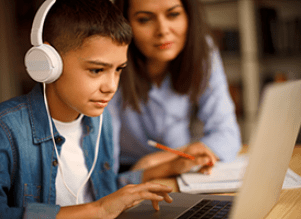12/13/2020
Engaging Emergent Bilinguals Right Now with the Right EdTech Solution
Student engagement has never been more important than it is right now. Unfortunately, it’s also never been more challenging to engage students as we continue to adapt to at least some form of remote learning.
The good news? Educators are rising to the challenge—just as they always do—learning new technologies, creating new lessons, and developing alternative approaches, all while adhering to ongoing curriculum and state and district requirements for remote learning.
The not-so-good-news? While the pandemic has shed more light on inequity, revealing to more stakeholders the many equity gaps that exist in today’s classrooms, it may also be widening them (Seale, 2020). Of particular importance to educators and district leaders are emergent bilingual students, or English language learners. Finding ways to connect with and engage this growing US student population—currently 5 million and counting—is essential (Quintero & Hansen, 2017).
Briefly, here's why engagement matters so much
Across all subject areas and educational activities, research shows a strong correlation between student engagement and student achievement. The more students are engaged, the more they feel connected to their academic experiences and develop more positive attitudes (Bridgeland et al., 2006).
Non-engagement or disengagement, on the other hand, can lead to a number of negative outcomes, from poor academic performance to higher dropout rates. When students struggle academically and socially or feel unwelcome, they can become less motivated, which can be compounded over the years. For example, academic lessons that aren’t culturally responsive can make an emergent bilingual student feel insignificant, resulting in lack of motivation and disengagement (Ferlazzo, 2015). (Learn more about the importance of student engagement for emergent bilinguals in the Rosetta Stone infographic, Engaging Emergent Bilingual Students with Educational Technology.)
Engagement in the age of COVID-19
The transition to online learning during the pandemic has presented new barriers to engagement—namely, uneven access to technology, spotty WiFi connections, lack of adult supervision, and/or additional family responsibilities for students (Goldstein et al., 2020).
Beyond schools distributing tablets to those who need them and providing offline resources in addition to online ones, the key to providing equitable learning opportunities for all students may be to assess what works for each student’s unique situation (Seale, 2020). In other words, what’s the best way to engage each individual emergent bilingual right now?
Educational technology that addresses many specific needs
Assuming students have access, educational technology has proven to be an effective way to engage emergent bilinguals in both academic and English language lessons. (Rosetta Stone understands this and is currently offering students three free months of Rosetta Stone for Students.)
In one study, emergent bilingual Kindergarten students who used the Lexia Reading program in addition to core reading instruction showed greater gains than a control group in overall reading, phonological awareness, and word reading (Macaruso & Rodman, 2011). In yet another study, emergent bilinguals showed gains on the GRADE reading assessment equal to or slightly greater than students who are not English learners. These results point to benefits of the Core5 program for students with a diverse range of English language skills (Prescott, et al., 2018).
One way to better engage emergent bilingual students right now is to utilize not just any online tool or resource, but rather, the right one—a solution that addresses specific, individual needs. The right learning solution can help improve emergent bilinguals’ engagement by providing:
- Real-time data—this is especially useful now, as it allows educators to remotely track students’ levels of knowledge and proficiency in order to personalize learning
- Opportunities for the development of intrinsic motivation—this can be achieved with a tool that allows for choice, provides a visual representation of progress, and enables students to see themselves in the program’s stories and characters
- Culturally responsive pedagogy—honoring emergent bilinguals’ heritage languages and cultures can help them feel connected and engaged
- A variety of media—video, interactive characters, and gamelike activities can motivate and engage students in new and individualized ways
- Independent learning opportunities—these allow emergent bilinguals to learn at their own pace and appropriate level, cutting down on frustration and boredom and making it easier for them to stay engaged
- Ongoing assessment—again, right now, this is vital, as educators can access information regarding student strengths and weaknesses or gaps, allowing them to target instruction for better student engagement
Supporting the educators who support our students
As remote learning in some form or another continues, student engagement isn’t just imperative—it’s everything. A blended learning approach that includes the right educational technology solution can provide educators with the data and resources they need to better personalize instruction for and build relationships with their emergent bilingual students. Ultimately, it is these relationships that will keep students engaged, learning, and succeeding.
Educators and administrators seeking additional ways to improve emergent bilinguals’ engagement can download the Rosetta Stone eBook, Student Engagement: An Essential Ingredient for the Success of Emergent Bilinguals. For more information about Rosetta Stone language solutions, reach out today, and a K–12 language expert will be in touch.
References
Goldstein, D., Popescu, A., Hannah-Jones, N. (2020). As school moves online, many students stay logged out. New York Times. Retrieved 5/20/20 from https://www.nytimes.com/2020/04/06/us/coronavirus-schools-attendance-absent.html.
Macaruso, P., & Rodman, A. (2011). Benefits of computer-assisted instruction to support reading acquisition in English language learners. Biling Res J. 34:301-315.
Prescott, J.E., Bundschuh, K., Kazakoff, E.R., Macaruso, P. (2018) Elementary school–wide implementation of a blended learning program for reading intervention. J. Educ. Res. 111(4):497-506.
Quintero, D. & Hansen, M. (2017). English learners and the growing need for qualified teachers. Brookings Institute. Retrieved 6/16/20 from https://www.brookings.edu/blog/brown-center-chalkboard/2017/06/02/english-learners-and-the-growing-need-for-qualified-teachers/.
Seale C. (2020). Distance learning during the coronavirus pandemic: equity and access questions for school leaders. Forbes. Retrieved 6/16/20 from https://www.forbes.com/sites/colinseale/2020/03/17/distance-learning-during-the-coronavirus-pandemic-equity-and-access-questions-for-school-leaders/#600cd2fc1d4d. .

